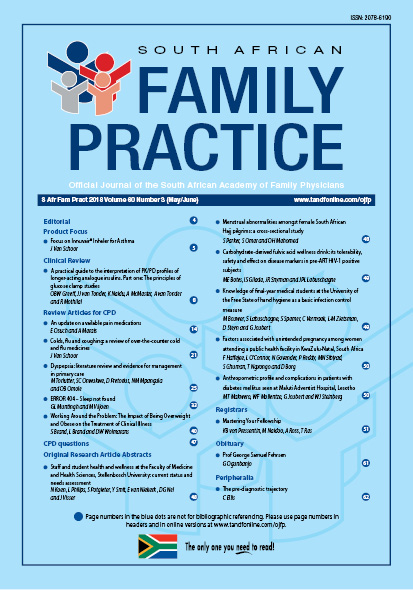Staff and student health and wellness at the Faculty of Medicine and Health Sciences, Stellenbosch University: current status and needs assessment
Keywords:
health sciences, health screening, online survey, staff and student wellness
Abstract
Background: Emphasis is currently placed on the importance of employee and student wellness initiatives. The aim was to assess staff and student health status at the Faculty of Medicine and Health Sciences (FMHS), Stellenbosch University (SU), and to conduct a wellness needs assessment. Methods: Online, self-administered questionnaires were used to collect data concerning staff and students. Additionally, students’ anthropometric and biochemical parameters were assessed. Summary statistics, correlation coefficients and appropriate analysis of variance were used for data analyses. Results: Data were obtained from staff (survey: n = 300) and students (screening: n = 536; survey: n = 330). Some 58% (n = 174) of staff had a self-reported BMI of ≥ 25 kg/m2 whilst mean screening values for all variables fell within normal reference ranges for students. In all, 78% (n = 232) of staff reported to exercise < 150 min/week and 28% (n = 91) of students were sedentary for > 8 h/day; 63% (n = 188) of staff expressed the need to make better food choices, 17% (n = 55) of students were aware of the need to change but experienced reluctance, and both staff and students felt dietary assistance would be beneficial (43% vs. 46%). In addition, 79% of staff (n = 208) and 42% of students (n = 138) reported being under constant pressure. Conclusion: Much can be done to improve the health and well-being of both staff and students at the FMHS, SU. Wellness is a multifactorial concept; as such, health-promotional strategies for classrooms and workplaces should consider all factors in order to provide a holistic approach and potentially identify those who are at risk of a sub-optimal wellness status. (Full text of the research articles are available online at www.medpharm.tandfonline.com/ojfp) S Afr Fam Pract 2018; DOI: 10.1080/20786190.2017.1396788
Published
2018-07-12
Section
Research Articles
By submitting manuscripts to SAFP, authors of original articles are assigning copyright to the South African Academy of Family Physicians. Copyright of review articles are assigned to the Publisher, Medpharm Publications (Pty) Ltd, unless otherwise specified. Authors may use their own work after publication without written permission, provided they acknowledge the original source. Individuals and academic institutions may freely copy and distribute articles published in SAFP for educational and research purposes without obtaining permission.

